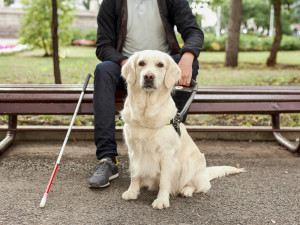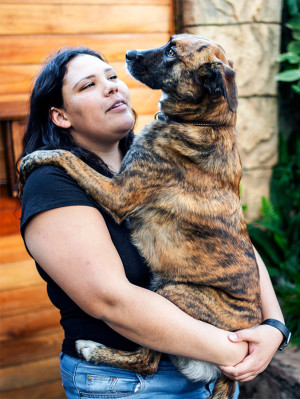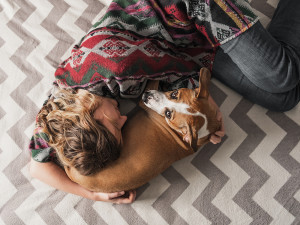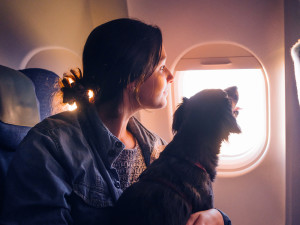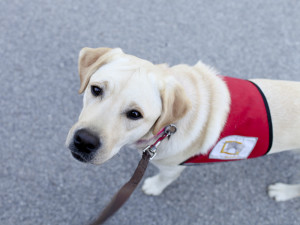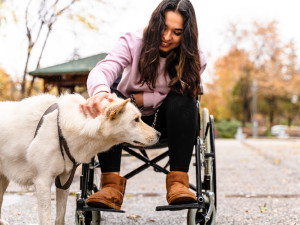Can You Have a Service Dog for Anxiety?
Definitely something worth looking into.

Share Article
In This Article:
What is Anxiety? What are Service Dogs? How to Get a Service Dog How to Train a Service Dog for Anxiety Benefits of a Service Dog
Whether you’re walking around town or strolling through the airport, chances are you’ve seen a service dog in action, sporting a bright red vest and a laser-focused demeanor. We stand in awe of these pups who help their humans navigate challenges and provide unwavering support.
If you’re someone who suffers from anxiety, you may be wondering if you can have a service dog to help you get through daily life. Thankfully, you can, and dogs really excel at providing the kind of companionship and assistance that can make a significant difference in managing mental health (did we really need more proof that we don’t deserve dogs?). Learn more about having a service dog for anxiety, how these amazing companions impact our mental wellbeing, and any guidelines you need to know to register your dog.
What is anxiety?
Anxiety is a mental health condition in which individuals experience persistent, excessive worry or fear about various aspects of life. It can manifest in physical symptoms such as restlessness, rapid heartbeat, and difficulty concentrating, and can significantly impact daily functioning. Some people experience anxiety occasionally, while others suffer from it chronically.

Many individuals use service dogs for anxiety as part of a comprehensive support system. This will typically be recommended by a medical or mental health professional in addition to other therapeutic interventions, such as counseling, medication, or coping strategies. The goal is to create a holistic approach to managing anxiety, with the service dog playing a vital role in providing tailored support.
What are service dogs?
Service dogs are animals that provide support for individuals facing various physical or mental health challenges. These highly trained companions go beyond being just pets; they’re essential partners to people with disabilities and help them lead more independent and fulfilling lives.
Service dogs are carefully selected and undergo extensive training to perform specific tasks tailored to their human’s needs. While commonly associated with physical disabilities, service dogs can also be trained to assist people with anxiety and other psychological conditions. If you observe a service dog for even a second, you’ll notice the incredible bond that develops between them and their human companion.
What are psychiatric service dogs?
Psychiatric service dogs (PSDs) are dogs that are trained to help people who suffer from mental and emotional disorders. Individuals with conditions such as anxiety, depression, post-traumatic stress disorder (PTSD), and other psychiatric challenges can benefit from the support of these specially trained animals. These dogs undergo extensive training to perform specific tasks that assist their humans in managing and mitigating the symptoms of their condition. From providing comfort during panic attacks to creating a buffer in crowded spaces, PSDs are key to providing humans relief from symptoms associated with mental health disorders.
Emotional support animal vs. psychiatric service dog
If you want a service dog for anxiety, a psychiatric Service Dog can provide daily support customized to your specific needs. Another option is to get an Emotional Support Animal (ESA), however, there are some key differences between these dogs and service dogs.
“The primary difference lies in their training and legal recognition,” says Adam Guest, dog trainer and founder at Raw Freshopens in new tab. “Emotional support dogs provide comfort through their presence and require no specific training. In contrast, service dogs are trained to perform specific tasks to assist with a disability, including mental health conditions like anxiety. Legally, service dogs are granted more access rights to public places compared to emotional support dogs.”
A medical or mental health professional can help you decide which is best based on your condition and needs. To break it down further, here are the main differences between ESAs and PSDs:
Permissions: ESAs are not granted public access rights and are primarily for providing comfort within the home. On the other hand, PSDs are trained to accompany their humans in public spaces, including restaurants, stores, and transportation. For example, if you’re traveling via plane, an ESA has to go in a carrier, while a PSD does not.
Training: Emotional support dogs do not require specific training for tasks, but should exhibit good behavior. PSDs undergo rigorous training to perform specific tasks that mitigate their human’s anxiety symptoms.
Documentation: While neither PSDs nor ESAs require formal certification, if you’re traveling with your PSD, you’ll have to fill out documentation stating that your dog has been properly trained. The requirements can vary by airline and where you’re traveling.
How to get a service dog for anxiety
If you’re wondering how to get a service dog for anxiety, there are specific steps you should follow to make sure you and your future companion receive the appropriate support:
Get a recommendation: The first step is to get a recommendation from a licensed mental health professional. This document outlines the necessity of a service dog in managing your anxiety-related condition.
Find a service dog provider: Once you have the recommendation, you can proceed to find a reputable service dog provider or choose to train your own service dog with professional guidance. Thorough training and socialization are key to making sure your service dog can perform the necessary tasks and behave appropriately.
Get some gear: A service dog vest or collar, while not a requirement, is a good way to let others know that your animal is a service dog. The last thing you need is TSA badgering you to put your dog in a carrier when you don’t need to.
Know the rules: Familiarize yourself with local laws and regulations regarding service dogs to understand your rights and responsibilities. For example, there are only a few types of questions people are legally allowed to ask you regarding your service dog.
Because there is no official registry or certification for service dogs recognized by the U.S. government, be cautious of online scams offering registration or certification for a fee. Legitimate service dogs are defined by their training and tasks, not by a registry.
How to train a service dog for anxiety
If you’re wondering how to train a service dog for anxiety, one of the best ways is to work with a professional organization that specializes in this type of training. When it comes to service dogs, training goes way beyond your typical cues like “sit” and “stay.” These dogs have to know specific tasks that assist with anxiety-related conditions.
For example, tasks might include “alert” (to nudge or paw the individual when signs of anxiety are detected), “brace” (for physical support), and “retrieve” (to get medication or a phone). Professional trainers understand the nuanced needs of individuals dealing with anxiety and can tailor the training program so your pup is up to snuff on everything they need to do.
If you want to go a different route, you are allowed to train a service dog for anxiety yourself. However, this option requires dedication, consistency, and a deep understanding of the specific tasks the dog needs to perform. While self-training is a viable option, getting guidance from experienced trainers or organizations will definitely increase the effectiveness of the training process. Whether you choose professional training or opt for self-training, the key is to focus on the unique tasks that will best support your individual needs and enhance your quality of life.
“When training a dog to assist with anxiety, it’s crucial to understand that the dog is not just learning commands, but also how to read and respond to emotional cues,” Guest says. “This training goes beyond basic obedience and enters the realm of emotional intelligence and sensitivity.”
Here are some key things to keep in mind when training a service dog for anxiety:
Build a deep bond: Strengthen the connection through daily care and positive interactions, giving your dog a chance to tune into your emotional state.
Sensitivity training: Teach your dog to recognize and respond to signs of anxiety, such as shallow breathing or restlessness, through simulated exercises.
Desensitization to various environments: Gradually expose your dog to different settings, reinforcing calm behavior amid distractions to make sure they stay focused.
Task-specific training: Train your dog to perform tasks like retrieving medication or providing deep pressure therapy during anxiety attacks.
Ongoing training and socialization: Continuously reinforce learned behaviors and introduce new skills, making sure your dog is comfortable and well-adjusted in social settings.
Benefits of a service dog
Other than being incredible companions, having a service dog has many benefits for people who suffer from anxiety. A service dog can provide a sense of security, reduce feelings of loneliness, and help manage panic attacks or other uncomfortable symptoms.
“The presence of a service dog can also improve overall mental health, encourage social interaction, and promote a routine that can be beneficial for those dealing with anxiety,” Guest says.
These are just a few of the advantages you can expect when you have a service dog by your side. If you're considering getting a service dog, consult with a mental health professional to determine if it aligns with your specific needs and circumstances. They can provide guidance on whether a PSD or ESA would be a beneficial addition to your treatment plan and help you navigate the process.
FAQs (People also ask):
What if you don’t qualify for a service dog?
If you don’t qualify for a service dog, there are plenty of other options available to support your mental health and well-being. ESAs are a great option for individuals who may not meet the criteria for a service dog but can still benefit from the companionship and emotional support provided by an animal.
What breeds are the best for service dog work?
The best breeds for service dog work often possess qualities such as intelligence, trainability, calm temperament, and a strong desire to please their pet parents. Breed is not the sole determinant of a successful service dog. Individual temperament, personality, and aptitude for training play significant roles in determining a dog’s suitability for service work.
Can you be denied entry with a service dog?
While service dogs are generally allowed entry to most public places under the Americans with Disabilities Act (ADA), there are rare circumstances where they may be denied entry. However, denial is typically based on the dog’s behavior, rather than its status as a service animal. For example, if a service dog displays aggressive behavior or poses a direct threat to the health or safety of others, entry may be denied.
What disqualifies a dog from being a therapy dog?
Dogs may be disqualified from becoming therapy dogs for various reasons, primarily related to behavior and temperament. Aggression, fearfulness, excessive shyness, or inability to remain calm in various situations are common reasons. Health issues that could pose a risk to the dog or others may also disqualify them.
Does my service dog need a vest?
While vests are not legally required for service dogs, they can be beneficial for identifying them as working animals. Vests can help prevent unnecessary interactions from the public and signal to others that the dog is on duty. Additionally, vests often provide pockets for carrying essential items like identification cards, medical information, or supplies. However, whether a service dog wears a vest ultimately depends on the human’s preference and the specific needs of the dog-handler team.
References:

Courtney Elliott
Courtney Elliott, a proud Cleveland native living in Manhattan, blends her decade of writing and editing expertise with her unshakable devotion as a pet parent to her French Bulldog, Gus. When she’s not at her desk, you’ll find her frolicking in Central Park or engrossed in a good book at a local coffee shop.
Related articles
![Backlit photo of a woman seated on an airplane holding her dog in her lap while they both look out of the open window.]()
You Can’t Fly With Your Your ESA, But Your PSD Is Welcome on a Plane
Find out how here, including what the heck those acronyms mean.
![A service dog for PTSD walking outside looking up at the camera]()
Service Dogs Can Ease Veterans’ PTSD and Anxiety, Studies Say
Trained service dogs can sense panic attacks, wake veterans from nightmares, and give all the healing cuddles.
![Person holding a corgi, shot from behind]()
Flying with An Emotional Support Animal
Are ESA alpacas and peacocks mocking people with real disorders? A service-dog owner and flight attendant get real.
![A brunette woman sitting in a wheelchair wearing a pink sweatshirt, black leggings, and brown Ugg boots petting an all white Shepherd mixed breed dog on a leash at the park outside]()
How to Register Your Dog as a Service Dog
The short answer: No animal registration is required, but service dogs still need to be properly trained.
![Woman petting her small service dog.]()
What People Can and Can’t Ask You About Your Service Dog
The questions will come, so you should be prepared with answers.
![Valentin Pujadas illustration]()
FYI, Pets Are Incredibly Good For Your Mental Health
Experts share the science-backed ways our pets offer us emotional support.
![two people bonding and smiling over a dog]()
Loneliness Is a Public Health Crisis. Pets Can Help
Per the US Surgeon General, loneliness is as dangerous for your health as smoking 15 cigarettes a day. Here are ways pets can solve that.
Do Anxious Dog Parents Raise More Anxious Dogs?
Which comes first: a nervous person or a nervous pup?
![Young woman hugging her small black dog on the couch]()
Who Has More Separation Anxiety — You or Your Dog?
It was a trick question. A study shows that the pandemic has made us all codependent.
